Issue Number 20, Spring 2013
Contents
- The World is Too Much With Us by William Wordsworth
- Beseech by Catherine Owen
- Blue Border of Extinction by Maya Khosla
- Bumblebees Do Fly by Pierre Dutertre
- Darwin Would Agree by Karen Terrey
- Dowser on the River by Tom Sheehan
- Good Animals by CB Follett
- Hawk Dream by Nellie Hill
- Letters from the Hinterland #4, Rapa Nui by Raymond Greiner
- Litoptern by Hilary Sideris
- May Storms by Nicol Stavlas
- Merenchytraeus solifugus by Ann Taylor
- Not Only Earth by Ellen McCarthy
- Planting a Garden by Ken Poyner
- Reviving the Lexicon by Monique Gagnon German
- Salmon by Susan Kelly-DeWitt
- The Last Tasmanian Tiger: London Zoo 1936 by Barbara Baldwin
- Tiny Ants without Sorrow by Grace Cavalieri
- Totems by Jamey Gallagher
- Where Will They Go? by Gail Newman
Archives: by Issue | by Author Name

The World is Too Much With Us
by William Wordsworth
William Wordsworth wrote this poem in 1802 while living with his sister in Dove Cottage in Grasmere in the Lake District of England.

The world is too much with us; late and soon,
Getting and spending, we lay waste our powers;
Little we see in Nature that is ours;
We have given our hearts away, a sordid boon!
This Sea that bares her bosom to the moon;
The winds that will be howling at all hours,
And are up-gathered now like sleeping flowers,
For this, for everything, we are out of tune;
It moves us not. ...
© William Wordsworth

Beseech
by Catherine Owen
Catherine lives on the edge of the Lower Fraser Estuary where it runs into Vancouver, BC, down from Hope. She regularly walks the trails by the water where one can encounter otters, bald eagles, herons and the occasional coyote.

Prolong me along the estuary
where the cataclysmic wildflowers, all their
poppy-joy-vermillion
smitten in pointillist manifold burgeon
& there are discarded rust hungers too beautiful
to not be
un-wedged from granite and shouldered home, such
bolts & rivets of ruin
have we here below the swallow tidbit draughts of
slight salt water
& slim oil from the tug-lovely voyages, green peeling
barges, power boats
and the occasional Sea-Doo though the fishing
lines continue to fall
from the small dreams of wharves while toddlers bucket
& cry on shorelines
passed by the endless joggers. O prolong me along the estuary there
is something in this thin stretch of eel grass & bulrushes where the tide skew-wiffs in
against the slow-eroding boardwalk that is hope-solemn, proven re-tuning
of what has been somewhat death-struck-numb and now wants, if living is what it does,
to be vole-slickery and gold-holy as those dandelions tall beside the Fraser
and of their origins, stone, perhaps, or song.
© Catherine Owen

Blue Border of Extinction
by Maya Khosla
Maya lives near Copeland Creek, which is a part of the Russian River watershed in Sonoma County.

Blue the suspended dive, a whale mired in netting.
Litmus blue, the alkalinity of a marsh in storm.
Blue the phone ringing and ringing in an empty house.
Blue irises tasting air.
Blue blinking populations, butterflies alive for a week.
Light a blue flame for coffee.
Blue tugboat pounds the air with motor-sized fists.
Blue the vastness underneath, tending toward darkness,
Blue of infinity commencing with sand-grain.
Blue the single whale far below listening for a song of reply.
Blue-gray blowhole sends out the stench of exhalation.
Blue the hunch of a canoe overturning, two inside,
the chance of survival, snorkeling past icebergs.
Slippery blue salmon lunging for unreachable waterfalls.
Blue the sliced loop-knots between whale eye and diver.
Sky’s dawn-blue tongue dissolving stars like salt.
Blue collar-bone-bruise from the canoe’s collapse.
Blue heart tightening in its cage-within-a-cage.
Silence, the netting cut loose, the whale freed.
Blue fabric of jet-stream brings a message from wings.
Blue the pressure, whale snout nudging each rescuer.
Blue to the power of blue and none of it enough.
© Maya Khosla

Bumblebees Do Fly
by Pierre Dutertre
Pierre lives within the Hillsborough watershed in central Florida, a few miles from the Hillsborough riverhead that is fed through natural springs. He regularly commutes to the Upper French Broad watershed in North Carolina where he crafts his photographic art. Pierre is an artist, educator and photographer.

I am not sure who started the scientific argument that bumblebees cannot fly.
Apparently, and according to my classmates in the aeronautics department at the Faculte des Sciences in 1972 Paris, the lift equations of the rigid bumblebee wings versus its weight ratio make it simply impossible for bees to generate any form of lift. The numbers do not add up for any remote possibility of flight.
And yet, bumblebees do fly. They fly and hover effortlessly between flowers, pollinating our most precious food resources. “They do fly.”
Forty years later, I arrive at a bed and breakfast in the remote mountain community of Barnardsville, North Carolina. A good friend recommended this place, very close to my intended photography explorations of the deep mountain forests. He described it as a holistic, organic, and very special place to stay. Although I am unsure as to what holistic is, and I have no particular affinity for all things organic, I was intrigued and contacted the innkeeper to book a five-day stay. On the telephone an elderly sounding gentleman asked me several odd questions: “What do you do?” “Why do you want to stay here?” “Are you afraid of bumblebees?” That last question intrigued me the most.
I miss the concealed and unmarked entrance to the B&B twice but finally make my way up a steep driveway to the main house on the left. I presume that a smaller structure to the right is the guest cottage. Both wooden buildings appear old and weathered, with flaking light green paint and large portions covered in vibrant ivy. In between I notice the massive terraced gardens rising upwards brimming with flowers, berry bushes and vegetables of all kinds, the organic aspect of the B&B, I presume. Just past the cottage on the right, a sunken quarter mile meadow meanders uphill between the high tree lines; later I will discover that this meadow continues uphill and switches back for another thousand-foot climb. The deep forest I seek is just a few hundred feet away.
As I step out of the van, an elderly gentleman greets me with a firm handshake, introducing himself as the innkeeper. He is very tall and sports a wild and unruly thick head of white hair. “Welcome to our humble residence,” he says with a mischievous smile. “Let me show you to your accommodation. I hope you will feel comfortable here.”
I follow him to the cottage on a narrow path made of local flat stones and up a flight of dilapidated wooden stairs that creak with every step. As we arrive on the large deck of the second floor, overlooking the meadow, I am completely astounded by the beauty of the view and the tranquility of this setting. However, this peaceful scene is quickly interrupted by the buzzing sounds of dozens of bumblebees that are flying around us. The innkeeper looks at me with a large smile and says, “I hope you don’t mind them. It’s really their place, not ours. They live in the roof and they are completely harmless”.
As we enter the room, two bumblebees fly past our heads and into the interior space. He tells me that this is a standard routine for them. “Just open the screen door when they have finished looking around and let them out.” Interesting.
Later that evening I sit on the deck absorbing the outstanding beauty and tranquility of the meadow. The bumblebees hover effortlessly a couple of feet above my head, defying gravity with minute wings and large colorful bodies. They seem to be looking at me with great curiosity. Each bumblebee performs that 30-second observation and then goes back to whatever it is that bees normally do. I wonder what they think as they observe me. Will they remember me when I come back to this magical place in a few weeks?
On the last day of my stay, I ask the innkeeper to reserve the room for my next trip in a few weeks. He looks at me puzzled: “Sadly, I have decided to stop renting the top floor of the cottage; it’s not worth it anymore.” I am taken back by his statement. He goes on to say that the steps and deck to the second floor are in need of complete reconstruction and the local fire marshal is concerned that there is only one way out from the accommodation. I ask him what his plans are, what he is going to do with the cottage. “What of the bumblebees?” I ask foolishly.
“I think that I will just try to maintain it the best I can, maybe replace a few steps, but I can’t take the chance of a guest getting hurt.”
I am devastated. After five years of staying in a variety of B&Bs, this is the only affordable place, and it has been so perfect for my artistic retreats. This is my personal paradise, where I finally feel totally comfortable. To hear that I cannot come back is a crushing blow.
A few days later and back in Florida, I feel compelled to call the innkeeper and ask him if he has thought some more on the future of the cottage. He informs me that he got a quote from a local builder to rebuild the steps, deck and install a second exit for the top floor. “It’s going to cost $8000, not anything I can afford.”
I cannot believe the words that come out of my mouth next: “What if I pay for these renovations? I could stay there several times a year. It would be a kind of advance payment.”
On the line there is silence. After almost a minute he replies, “Well, that sounds fair. If you take care of these repairs, the second floor is yours for, say, five years. I won’t rent it out anymore, so you can bring your own things. You’ll have to pay for breakfast, though, whenever you are here. How about four dollars for each day?” A great price for paradise.
“Please tell the contractor to be very careful with my bumblebees,” I reply and hang up.
Turning from the phone, something inside me lifts. Bumblebees do fly.
© Pierre Dutertre
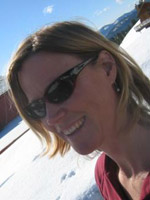
Darwin Would Agree
by Karen Terrey
Karen lives in Truckee, California, within sight of the Truckee River, part of the Lake Tahoe Watershed. The river runs about 120 miles from its source, Lake Tahoe, to its end in Pyramid Lake, just north of Fernley, Nevada.

Each soft thing emerges from the dirt
stamped by snow’s weight and cool April sunshine
gentles the living to live more.
People aren’t bad -
they’re just not good at all endeavors.
But it’s the multi-taskers that get eaten.
What’s left is the starkness
of what mattered,
and intent,
roots exposed, new leaders of stem
poking up anyway like a skinny foal leaning against a mare
because that’s what life does,
even if the wood cutter
the coyote
the heart breaker
have begun their inevitable approach.
© Karen Terrey

Dowser on the River
by Tom Sheehan
Tom lives in a house built in 1742 about 200 feet from the Saugus River in the Saugus River Watershed bounding 900 acres of the Rumney Salt Marsh and 450 acres of a wetland, Reedy Meadows.

Downriver a sudden
wash spills grubs, white
worms, into the quick rush.
Stones, too, hurl
into the fray, like infantry
and horse soldiers out of bush.
The rain is gone
over-hill half a day
and aches its echo on the earth.
This, of course,
is my own war, this drive
to be alone, separatist seeking
shadows of the pine,
the cool, dark cells of old trees
flattening like choice rooms by the banks,
and the phantom foe
sleek as a jet under surface.
He turns to watch my boots stumble
on the rock skelter
laced with lichen and mossed
strains. If he has laughter, it floats
away faint as photographs
at the back end of an old man’s
mind. I trust that he neither laughs
nor cries in his world,
that once he noses upstream,
feels the power gauging his flanks,
knows the message
burning like new stars
in the sanctity where his eyes dwell,
he will forget why I
am in this shadowed recess:
that a secret spawning calls us both
from the center
of the earth, the rhythm’s merge
divining where the river starts itself.
© Tom Sheehan

Good Animals
by CB Follett
CB lives in the Mt. Tamalpias watershed in Marin County, CA.

Where usually four or five circle,
yesterday a vast kettle of vultures
scoured the sky, winding their search
in a tight knot of wings.
I expect to see it in today’s paper:
dead man, lost child, something big enough
to draw the eager naked heads.
Animals that need to cross the road
can’t seem to learn
the danger of the warning hum,
grassless no-man’s-land, constant
rumble of gears and tires.
Thinking we are the only
ones who count,
we are not good animals.
© CB Follett
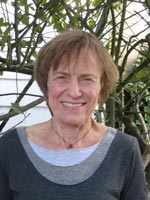
Hawk Dream
by Nellie Hill
Nellie lives in Berkeley, California, in the Wild Cat Creek watershed. "Hawk Dream" was inspired by a lunch-time drama in the Mt. Tamalpais watershed.

suddenly bright
like insight
a hawk floats
on a stream overhead
fish flapping in the claws
don't remind me because
it's wrong so unfair
that everyone has to eat
and this is how it happens
the fish thinks
somewhere within its
twisting body
within the searching fins
that it's swimming
think is the wrong word
it's a fact: the hawk is flying
with prey
the fish is swimming
it seems everyone I know
has seen something similar
at least once
it takes just once
one memory
as if it happened to you
real or in a dream
you think you're flying
trying to catch a ship that's already left
you're late
and where are you going
"Hawk Dream" won the 2012 first place Writecorner Press International Poetry Award and was first published on www.writecorner.com. It also appears in the author’s book, Winter Horse, from Finishing Line Press.
© Nellie Hill
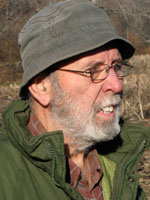
Letters from the Hinterland #4, Rapa Nui
by Raymond Greiner
Raymond lives with his canine companions Orion and Venus on 14 acres of remote forested and pasture land about three miles from the hamlet of Paragon, Indiana, in a cabin about 500 yards from the little-traveled road.

I've been reading a fascinating book, The Statues that Walked, written by Teri Hunt and Carl Lipo, a collection of archeological accounts and studies of Easter Island. There is much speculation about the origin and purpose of the many statues that are ubiquitous throughout the landscape on this island. There is accurate evidence as to where these large statues (called moai) were quarried, also some uncovering of the tools used to carve them. The enormity of the task is the most astonishing aspect; some statues are over 40 feet tall weighing nearly 70 tons, and many were transported up to seven miles from the quarry site. All the moai face inward away from the sea; they seem to be gazing back, in a vain search for the society that created them.
Mass voyaging migration to disperse the population of Polynesia began around 1000 AD, and the monument (moai) construction ritual began at about that time. The amazing aspect of Rapa Nui is the number of statues. It would be impressive even if there were only a few, but there are nearly 1000 of these giant statues scattered throughout the island. Some were broken in transport and remain lying where they were abandoned.
The Polynesian voyagers were the first inhabitants of Rapa Nui. they had no maps or charts; they relied on oral directions from tribal elders, following wind directions, star patterns, the setting sun and rising moon as navigational aids. They sighted birds before land, indicating a nearness to land. They used large double-hulled sailing crafts, planning voyages years ahead with the potential new island inhabitants chosen in childhood, training for years in extreme frugality regarding consumption of food and water, with the goal to find new settlements. These voyages were an ultimate human challenge, all happening 500 years before Columbus.
The Polynesians did not fear the sea as the Europeans did. They blended with the sea, and as an island culture extracted life-giving sustenance from it. Rapa Nui is extremely isolated and a great distance from the main Polynesian island group, also against the prevailing trade winds. It is likely the voyagers waited for an el nino, which causes a shift in wind direction allowing a more favorable voyage.
Easter Island was named by a Dutch explorer, Jacob Roggenveen, who arrived on Easter Sunday in 1722. At the time of discovery Easter Island was covered with a dense forest of palm trees, eventually succumbing to overuse and greed as the trees were harvested for building and the land cleared for crops. Today Easter Island has no trees; it is a barren place, and during modern times its inhabitants have been on the verge of extinction several times. It is now only a fraction of the culture it was in its prime. Easter Island remains one of the most remote islands in the world.
Such islands are like micro planets, revealing how practices of conservation and preservation can create and maintain a long history of survival, thriving and maintaining balance. In this case Easter Island thrived for hundreds of years, then was ravaged, and the results were devastating. Springs dried up, and there was no more timber wood for canoes or houses, no rope for moving statues, no fires for cooking. Life began to change as these losses created severe hardship and discomfort.
Paul Bahn and John Flenly were intense students of Easter Island and its history, studying the many works of various paleontologists and their findings. The deforestation of Easter Island was the cause of its severe cultural decline. Quote from their book Easter Island, Earth Island:
"The person that felled the last tree could see that it was the last tree but still felled it. This is what is so worrying. Humankind's covetousness is boundless. Its selfishness appears to be genetically inborn. Selfishness leads to survival. Altruism leads to death. The selfish gene wins. But in a limited ecosystem, selfishness leads to an increasing population imbalance, population crash, and ultimate extinction."
This idea has caused me to wonder about present day humankind, the ever-escalating drive to move forward without careful consideration regarding destructive practices that ultimately can reverse our development, as we venture slowly toward felling the last tree.
© Raymond Greiner
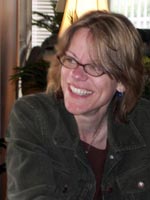
Litoptern
by Hilary Sideris
Hilary lives in Brooklyn, near Prospect Park, which lies on a ridge of terminal moraine that used to be under a sheet of ice one thousand feet thick.

Neither an even nor
an odd-toed ungulate,
the Litoptern, or simple
ankle, Darwin stumbled
on appeared a cross
between giraffe & camel—
humpless, horse-mouthed.
No speed, no herd could
keep her on the South
American continent,
safe from a saber-toothed
feline who craved
her slender neck’s
sweet underside.
© Hilary Sideris

May Storms
by Nicol Stavlas
Nicol lives in Bloomington, Indiana, in the Lower East Fork, White River Watershed.

We have grown used to May rain and to thunder, but these storms are not the ones we have known before.
After the first night of straight line winds we are without power for three days. The electricity comes back on the night of the second storm, and as the sky grumbles we wait for the flicker of light, for the darkness again.
The sirens sound four times before the storm hits our county. We go to the basement and return to our beds again and again. And then it is not the sirens, but the screech of train in the wind and the thick whip and crash of trees gutting into houses that drives us to the basement. We hear the violence, but do not know until the next day that as the wind moves through, it strips tree limbs from their trunks, pulls porches from houses, rips through roofs, splays shingles and debris into the road.
The storm travels northeast, tearing through the old trees in Seminary Park. In the thick stillness of the morning after, I huddle with a gathered band of strangers who snap pictures of city workers trying to manage the tragedy with chainsaws and backhoes. We stand together in the remnants of rain, the under-tree drippings, the fresh smell of storm. Someone says the trees are two hundred years old. I know they were so thick that three of us couldn’t reach arms around them this spring. The roots, un-buried and tipped skyward, are taller than the men who work to cut through them. There are other trees, felled but not uprooted, split at their trunks, stretching sharp wooden fingers to the sky. Someone says the trees were twisted by the winds, shattered. Someone says the storms will come again on Saturday.
The sound of chainsaws cuts through the days and nights of our neighborhood. Now the trees are left in piles- branches and thick wood on the ground- holes in the sky. By early afternoon, the sun is out, the breeze soft again. My daughter, who is not quite two, picks the plastered spit of leaves off of the front of our house and gets underfoot as I drag branches to the road.
We look to the sky. It is just summer again, humid and bright. The strawberries catch in the bit of glinted light that penetrates down beside the shadow of their leaves. Andjoli plucks them up, eats them, dripping juice down her chin. When she’s had her fill she squeezes the berries, wet in her fists, and turns the mush, like an offering, over to the neighbors who gather at the foot of our driveway. I take the sticky mess from her hands while we talk about where to get NOAA radios and batteries with all of the local stores closed, and who has power and freezer space, and if a tornado might follow the same line again, and how climate change comes when it comes home.
As we talk, we stoop to gather branches, piling them at the foot of the driveway, collecting the disaster. We have heard for a long time about climate instability, about the ways our refusal to limit our pollution and consumption will cause changes we cannot live with. We have been told this is coming, and so the storms do not surprise us, really. Still something has changed in how we understand the threat, the promise: we do not have the simplicity of charts and graphs, reports and weather predictions any longer. We cannot follow the spotty path of storms across the Midwest on the weather radar or in national newspaper reports. It is here, instead, in chaos, in our street, in our hands.
© Nicol Stavlas

Merenchytraeus solifugus
by Ann Taylor
Ann lives in eastern Massachusetts on a small hill overlooking a glacial pond that is part of the Mystic River Watershed.

In this land of Denali
vistas, picnics with bears,
icebergs huge and blue,
I’m startled by a one-inch
black thread surfacing
from Portage’s solid ice,
deliberately prodding into air.
This unique celebrity,
the “sun-fleeing” ice worm,
lives only in west coast glaciers,
rises at sunset, mates in frozen ponds,
burrows through block ice,
puzzles airlines,
ice cream companies,
organ transplant teams.
It stars in its own
Ballad of the Ice-Worm Cocktail,
and at Cordova’s February
Ice-Worm Festival
where Miss Ice Worm’s
fifty-foot, deep blue, red-eyed,
Chinese-dragon-style worm
meanders frozen roads.
The real one melts
above 41degrees,
disintegrates
with the gentle heat
of a human touch –
an unwanted
small new worry.
© Ann Taylor

Not Only Earth
by Ellen McCarthy
Ellen lives in the San Francisco Bay watershed, the most beautiful place she has ever seen.

This giant we stumbled on is
old, so old it was a sapling when
Rome fell and Aztec still was spoken
in these woods
where we stood, my friend
and I, staring skyward,
she in quiet prayer and I musing
whether life's dogged sundry forms
prove it must be sprouting
in countless starry gulches
of the Milky Way and far beyond
in ways an earthly brain can’t fathom.
We know Earth shimmers with a beauty
that’s finely tuned to human sensibility,
but not only human, and surely
not only Earth
© Ellen McCarthy

Planting a Garden
by Ken Poyner
Ken and his wife live in a forest of town homes, surrounded by a marcher land of track residences, all held back only by the Naval Base and the terror of the sea. All of this drains through the Lynnhaven-Poquoson watershed - part of the superlative Chesapeake Bay watershed -- to the Chesapeake Bay and the Atlantic Ocean.

The farmhouse is eaten with kudzu
And no breakfast will come from its kitchen.
The barn has only three sides,
And but half a roof. I am not impressed.
The ghosts of old families
Do better with this land
Than would a live family living with their
Sixteen dollar hair cuts and free
Cell phones. I can see
The shadow harvest laid out still
Geometrically perfect in the field.
I am looking for a fence.
In a place like this an ordinary girl
And I could fall in love: any other girl
Would be too far away. Our courtship
Would be penned in by time and technology,
Our love a product of what you can do
With this land and the implements
That, in that era, existed to work it.
I can imagine the pale
Understanding of paddock etiquette,
The emotional acceptance of the mechanical:
The flat practical shaping of our days;
And life always a Sunday off,
A market away, wicked with weather,
And in the exchange but a cartoon
Drawn by people who can afford transgressions.
I want those ghosts.
I want my alternatives to be few.
I am not so much
But I am here:
And the abandoned door comes off its hinges
When I apply my full want of sin against it,
With the last of the floor boards breaking to welcome me.
Oh dear broken down brethren,
I am home.
© Ken Poyner

Reviving the Lexicon
by Monique Gagnon German
Monique lives along the Susquehanna River Basin in south-central Pennsylvania, writing poems above the Codorus Creek watershed.

This is a sentence, spliced,
edited out of existence
by three sandpipers
flitting over sand and seaweed
as waves pooled a curved edge
around their spindle legs.
This is half the same thought
as it resumed in the car
on the way home from the beach,
before the third traffic light, red
and the sitting for the green,
the radio and its split personalities
battling for air space.
This is one word from the essay
on new beginnings, a revived string
of syllables and structuring
that began that same evening
but stalled and went silent
as the sun slipped down
into clouds on the horizon
and lit them up peach.
This is one chorus of a ballad
that came up singing
from dinner's macaroni & cheese,
a ditty torn up by the wind
that started after midnight
between two trees,
a gale that left one note hanging
like an orphaned leaf,
twitching either to hang on
or to get free.
This is just one tiny speck of ink
left by the pause of my pen
while I was almost entirely
out of the room in my thinking
about the moon and how it looks
at 3 then 4 in the morning;
how it is just a mirror
to the sun's interruptions
and without those periods
of punctuation, how dark
and glum it would be.
© Monique Gagnon German
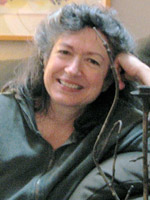
Salmon
by Susan Kelly-DeWitt
Susan lives in the Lower Sacramento Watershed, about two miles from where the Sacramento and American Rivers meet.

They came up the river like a band of slick
thieves. The water was thick with their leaping.
They climbed together the ladder of rapids,
hurled themselves and scraped their bellies.
The dead ones floated like pickerel weed. Many
fell out of the river of time, littering the rocky
banks, drawing the rats, raccoons and badgers.
They filled like windsocks with death.
We came there. We carried our eyes
and our baggage of witnessing. We carried
our awe like a causal fin. The willows crept
down to the river’s edge and hung their heads
like sad old men, trailing all their living
silver green leaves, their dusky olive leaves
the color of salmon skin. The beached ones dried
in the sun; they poked like stiff flags from the weeds
and the light passing over them seemed dis-
embodied, preternatural. Somewhere
in the worlds between this one and the dead
river of salmon ghosts, we heard a howling.
O Coho, O Kokanee, O Chinook.
Previously published as To A Small Moth, Poet’s Corner Press
© Susan Kelly-DeWitt

The Last Tasmanian Tiger: London Zoo 1936
by Barbara Baldwin
Barbara lives near the Spokane Aquifer and works at re-homing abandoned cats and dogs while feeding sparrows and assorted Corvids throughout the year.

That lone beauty, snuffling through
wire, was captured on film, pacing, pacing.
When the photographer clicked
his cold-eyed shutter closed,
this rare marsupial lion
was a living "museum piece."
The Aboriginals called them: "coorinna,"or "laoonana."
Then, the Aboriginals were gone.
The thylacine, waited
by the fence, wanting
meat, seeking not dirt, wooden slats
or dead leaves, but grass green quiet.
Men with books and glasses,
logged details: the rear-opening
pouch, the thirteen stripes, the wide
"snake-like gape," a simple yawn,
followed by a distinctive "cough-like bark."
There had been three animals
in the Hobart zoo.
One keeper used a worn broom
to wave the fearsome trio
into the man-made den.
He knew nothing about these beasts.
They were simply kept ...
until only the male survived.
The isolate, dog-like,
was like no other, living on scraps,
penned up in a "half-house."
He amazed one man as he:"...sprang from the floor
to the top of the wall, from crossbeam
to crossbeam, like a cat."
The survivor was a fable soon forgotten.
His passing was a palm-sized
rectangle, buried in the news.
© Barbara Baldwin
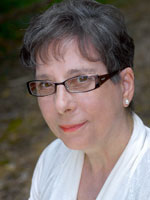
Tiny Ants without Sorrow
by Grace Cavalieri
Grace lives and writes in Annapolis, Maryland, by the beautiful Chesapeake Bay, which is coming back to life with new fish, new hope, new streams.

A string of tiny mites ,
thematic elements of nature,
climb the beach house wall.
What vibration causes them to stop, confer
with another line, then move on, we’ll never know.
Over and over like a prayer, they go.
These infinitesimal creatures, moving in unison, reach
another set of beings, freeze, then begin again.
Protean intelligence with an elegant sense of balance,
—with sensibility unfailingly sure of its path—
They do not have wounds too deep for anger.
They do not need to elevate the struggle.
© Grace Cavalieri

Totems
by Jamey Gallagher
Jamey is about to move from the shores of the Tuckahoe River to the Gunpowder-Patapsco Watershed.

1. Tadpole
Our family called it the “Swift River,” which was suburban American for “Pemigawasset.” We would wake up early on a Saturday or a Sunday, well before sunrise, and climb into the blue Ford. If we were lucky enough to make it to the White Mountains before other families, we would get our spot—across the river from a small falls, an oval of hard sand large enough for only one family, two if the other family was pushy enough.
The Pemigawasset River was always cold, the numbing cold of snowmelt, and if we swam at all it was for only short periods of time. We would swim to a flat granite boulder in the middle of the river, always crowded with jumpers. My favorite thing about the Swift River, when I was eight years old, was the existence of tadpoles that darted in the shallow pools of perfectly clear water surrounding the sand. These tadpoles were thick and black, with flagellating tails. They seemed far more substantial than the tadpoles near our house. I would imagine squeezing their plump bodies as I collected them in buckets and watched them swim. The cold, clear water would catch the sunlight, and the blue or green plastic would seem to glow, and inside the bucket black shapes would dart like shadows.
Sometimes my parents would allow me to bring a number of tadpoles home in carefully covered buckets. After a two-hour drive south, we would place them on the driveway before our orange split-entry house. They seemed less magical in this setting.
I don’t remember exactly what we did with the tadpoles after we got them home, but I know that they died pretty quickly.
Our relationship to animals, with animals, is mysterious. We use them to fill symbolic slots that we don’t know how to fill otherwise. Some animals become totems of innocence. We know that animals are not innocent, but we forgive them their savagery. Other animals take on the guise of the unknown. We look into their eyes and see ourselves—but also something sublime.
2. Toad
I never intentionally killed anything until I was 10 years old. A neighbor and I found a toad in his backyard near a large woodpile. It was summer, and the woodpile was stacked tight. We lifted the toad from the long grass and passed it from hand to hand, waiting for it pee on our palms, feeling its rough and smooth skin.
“Throw it against the woodpile,” my friend said.
I stood about fifteen feet from the woodpile. I wound up, using skills I had learned as a decent Little League pitcher, and let the toad go. The second that it left my hand I felt something happen to me. A reaction of the body. I wanted to get the toad back, but it was too late. I watched it spin in the air, its stubby back legs flipping over its front. It hit the side of the woodpile with a dull, wet thud before dropping. Pink oozed from its open mouth.
I acted like it didn’t matter. This was just the kind of thing that boys did.
We think of animals as symbols, but it’s not always clear what those symbols represent. Animals are over-determined signifiers. Us, not-us. Wild, domesticated. Ugly and beautiful. At different times of our lives animals represent different things, depending on our needs.
3. Moose I
I spent most of my high school years doing stupid things. Drugs, punk music, minor acts of vandalism. My friends and I were idiots, and every few weeks we would drive up to the White Mountains, where, for a couple of hours, we would stop being idiots. During winter, we’d walk down empty paths and follow ice-choked rivers. In our Doc Martens and Converse All-Stars we’d slip off rocks, fall and laugh, our denim jackets too thin for the cold, gaping at the pink and purple and blue of the ice.
Once, we drove up to Canada, leaving our safe suburban homes in southern New Hampshire at 11 p.m. We stopped at a convenience store and bought Spam and crackers, which served as our dinner. I drove my first car, a red Subaru wagon.
We were on the Kancamagus Highway driving fast over snow-heaves when I saw a dark shape on the road ahead of us and pressed the brakes. The road had been recently plowed and the tires grabbed asphalt. We stopped about two feet away from the substantial side of a moose. Its fur was brown and black, matted, and it turned its huge skull to look in our direction. Over the top of the car, I don’t think it even saw us. It was probably eight feet tall, its rack as big across as the car.
“Holy shit,” someone in the backseat said.
All I could do was nod.
We are not wild, and animals are not (ever, truly) domesticated. But nothing really separates us. You don’t think animals tell themselves stories about the world?
4. Moose II
Now I am the father of two daughters. In many ways I am still an idiot. There’s only so much I can do about that. One recent May an old high school friend and I took our kids camping in the White Mountains. It was colder than we’d expected, and it rained for almost the entire weekend. Even in the damp, we were able to build campfires, and we kept warm telling ghost stories, but in the middle of each night rain fell hard, pinging against the plastic tent cover. My tent leaked, and I had to shift my three-year-old out of the frigid pool of water that had collected inside and lie in the puddle myself, shivering, soaked through. No one complained, but we were all miserable.
During the second day, the clouds broke and the sun emerged briefly. We drove down the Kancamagus at about five o’clock, toward dusk, my friend driving his twins in his truck while I followed in our car. We pulled over to the side of the road. Out in some mountain fields, full of brambles and dead trees and white birch, we saw five moose, both large and small, both young and old, walking slowly toward a stand of trees. The last of the sun lit the wet woods. I looked over at my two daughters, who sat staring out the windows.
“What do you think, guys?” I asked.
“Magnificent,” my three year old said. It was her word of the month. She’d been saying it everywhere, for every conceivable reason. Usually it was just something to smile at—a cute bit of precocity. Right at that moment, though, it fit.
© Jamey Gallagher

Where Will They Go?
by Gail Newman
Gail lives in San Francisco’s Mission Bay Watershed. Adjacent to her house is an open field park of native grasses and plants where she often spots various birds including red-tailed hawks, kestrels, meadowlarks, sparrows and robins.

The willows, the windows
The swans, the trellises, the girls in green dresses
Where will they go, the streets, the kisses
The near hits and misses
The firm hand and soft day
Gloomy room, sleek white moon
Shattered glass beneath heel of bride groom
Bride in white veil, hoe and nail, beetle, snail
Where will they go, the wild cheering crowd
The battered ball, the loud smile
The lover of stones and stems, the child
The big woman and small man
The bones in the grave
The soul in the body of the slave
The synapse of mind
The bullet in wind
The breath of the earth
The earth, the earth where
Will it go?
Previously published in the author’s book, One World, Moon Tide Press. Photo by Rebecca Bloom.
© Gail Newman